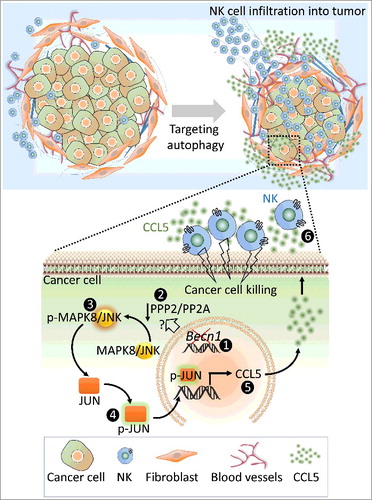Figures & data
Figure 1. Targeting autophagy decreases the tumor volume of syngeneic transplanted B16-F10 melanoma by inducing the infiltration of natural killer (NK) cells into the tumor bed. Up: Targeting BECN1 in tumor cells induces the overexpression and the release of CCL5 involved in the traffic of NK cells to the tumor microenvironment. Down: The molecular mechanism underlying the overexpression of CCL5 in BECN1-defective cancer cells. Targeting BECN1 by a genetic approach (1) leads to a decrease in the phosphatase activity of PPP2/PP2A by a mechanism not yet understood (2). Such a decrease induces the phosphorylation of MAPK8/JNK (p-MAPK8/JNK) on Thr185 and Tyr183 residues (3). Subsequently, p-MAPK8/JNK phosphorylates JUN/c-Jun (p-JUN/c-Jun) on Ser63 and Ser73 residues, (4) which binds to the promoter of Ccl5 and induces its transcription (5). CCL5 released by BECN1-defective tumor cells binds to CCL5 receptors, expressed on the surface of NK cells, and induces their infiltration (6). Functional NK cells recruited to the tumor site kill cancer cells and thereby reduce the tumor volume.

